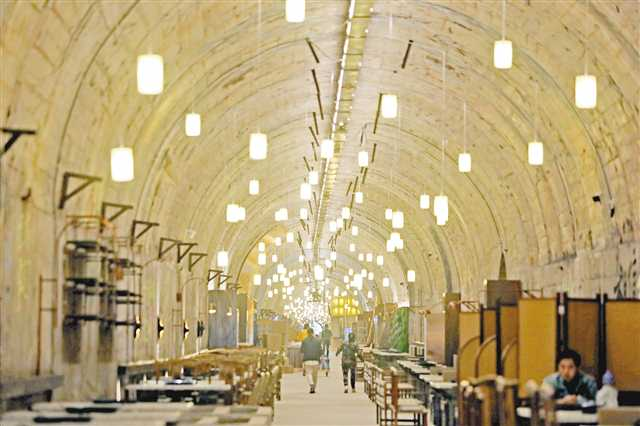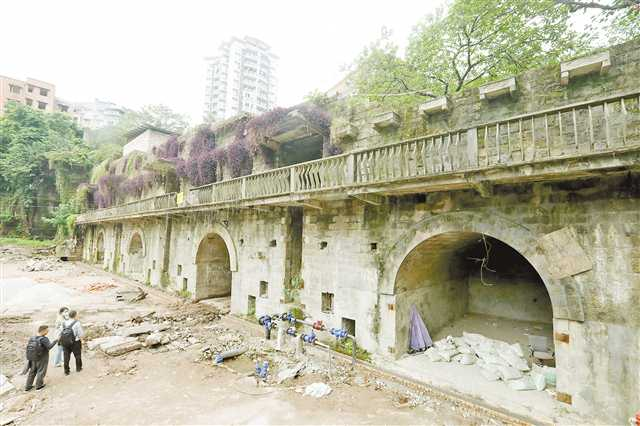Chongqing News
The largest air-raid shelter cluster in central urban area of Chongqing
2023-10-26 14:19:58


CHONGQING (CQNEWS) -- Air-raid shelter, as the life shelter of the people during wartime, is an important historical symbol of Chongqing. According to incomplete statistics, Chongqing has more than 1600 air-raid shelters, with a total use area of about 1.1 million square meters. Their quantity and scale are great and rare in the world.
Among these air-raid shelters, there is an air-raid shelter cluster which is quite mysterious. It “hides” along Yubei Longtousi Park to Jiangbei 9 St., with internal crisscrossing.
This is the largest known underground building with the longest single hole located in the central urban area of Chongqing by far, and it can be called an “underground city”. But until now, most people in Chongqing were unaware of its existence. Until recently, when a commercial project was about to be unveiled here, the air-raid shelter cluster was known to the outside world.
How big is this “underground city”? What was it used for? What is it used for now? The reporter recently had an exclusive look.
Air-raid shelter cluster lies in the downtown area
At 14:00 on August 24, Wuhong Road was busy with traffic. The reporter departed from Line 6 Exit 1A at Wuhong Road, and walked along the sidewalk to Longtousi Park to look for the said “underground city”.
About 2 minutes later, the reporter entered a trail next to the south gate of Longtousi Park. Walking further about 200 meters, at the foot of a small mountain, the reporter found a large air-raid shelter. Moving forward, the reporter found seven air-raid shelters of the same size, and the eight shelters are lined up one next to the other. Among them, six shelters are exposed, and the other two shelters are covered by a building that perfectly integrates with the mountain, and you can’t find it if you don’t look carefully.
Standing outside this air-raid shelter cluster, there are many tall buildings standing on the mountain, which is quite spectacular. Citizen Liu Bo told the reporter that he had lived in the community above the air-raid shelter for nearly 10 years, and had not known such air-raid shelter cluster.
What is even more peculiar is that this air-raid shelter cluster is located in the middle of a three-layer three-dimensional space, with tall building above it, and Hongtudi Rail Transit Station diagonally passing through. Every day, rail transit trains whizzes under the air-raid shelter cluster.
18 air-raid shelters form a net
As for such an air-raid shelter cluster located in the downtown area, what is it like inside? The reporter, with a flashlight, entered the air-raid shelter to make a closer look.
In the shelter, the cool breeze blew from time to time, but the reporter did not feel cold. The roof and walls of the shelter are made of concrete, and rusty steel bars are still visible. The ground of the shelter is also paved with cement. The reporter visually measured that the shelter was about two stories high, and the ground can accommodate two trucks side by side.
Slowly moving forward in the shelter, the reporter found that there’s a branch cluster at every distance. Walking along part of the shelter, the report could go to another air-raid shelter adjacent. The whole cluster thus forms a net, which can enable visitors to enter through one shelter and exit through another.
As the air-raid shelter connects the two districts, the reporter entered from the entrance of Yubei District, moved forward for about six or seven minutes, and came out from another shelter, then he found that he was already near the 9 St. of Jiangbei District.
Before then, after more than a month of exploration, an explorer found a total of 18 air-raid shelters in the mountain, with each one 6 meters high and 6 meters wide. Among them, the longest one is 520 meters long. The use area of the whole air-raid shelter cluster has reached about 20,000 square meters. It is well ventilated and not damp inside.
The “underground city” project is to be built
What was this huge air-raid shelter cluster used for?
The reporter learned that there was the former site of Chang’an Arsenal built in 1973 and completed in 1978. Now the former site has been discovered, and its commercial value has been appreciated.
The reporter saw in one air-raid shelter that more than 500 meters long inside, tables and chairs were placed on both sides, and lights were installed on the roof.
It will be the largest underground hot pot restaurant in Chongqing, covering an area of 3,500 square meters and accommodating 208 tables. Among them, the largest long table can accommodate 48 persons at the same time. The hot pot restaurant will start doing business on October 27 and will be open 24 hours a day thereafter.
It is understood that behind the hot pot restaurant, there is a large-scale “underground city” commercial project - Hujiayan Cultural Tourism Town which will be built into a cultural tourism complex in accordance with the 4A urban tourism scenic area standards. The whole project will be constructed in three phases, one of which will be built as hot pot restaurant, creative market, defense exhibition hall, and short-video broadcast base; the second phase will be built as stilted building, cafe and cave bar; and the third phase will be built as the park art block. (Translated by Liu Hongyan, Fathom Language Limited)
Editor:Jiang Yiwei
 手机阅读分享话题
手机阅读分享话题